Anil Das-Gupta is a Product Owner at Wargaming.
This article was originally published on Deconstructor of Fun.
In February 2017, Korean publisher Netmarble made a significant acquisition, purchasing Kabam’s Vancouver studio and some other minor assets for a reported $750 million. Why spend that money on a single studio?
Well the studio’s breakout hit Marvel: Contest of Champions, deconstructed brilliantly by Vinayak Sathyamoory in December 2015, clearly played a large part in it.
Mobile Card Games, Gacha and Dominating a New Genre

Rewind the clock back to 2012 and the mobile landscape was a very different beast.
This was a time when Japanese mobile giants Gree and DeNA decided to aggressively expand into the West, opening up new studios and bringing the world of gacha and mobile card games (sometimes known as Mobage’s, after DeNA’s old platform name) to the West’s attention.
Despite confusing and cluttered UI / UX these games had deep metagames with a very strong emphasis on collection, fusion, and gacha.
They made great revenues with Marvel: War of Heroes frequently in the top five grossing games and Transformers: Legends frequently in the top 20, using Rage of Bahamut’s card RPG framework.

These games were some of the hottest games on mobile for a six to 12 month window but ultimately dropped out of the charts altogether.
A slew of fast-follows from other companies followed and ultimately the lack of moment-to-moment gameplay caught up with them as mobile trends and tastes matured in the west.
hese games did, however, pave the way in the West for gacha systems and it was Kabam’s Vancouver studio who identified a gap in the market and exploited it in 2014 with their release of Marvel: Contest of Champions, a game that made over $100 million in its first seven months.
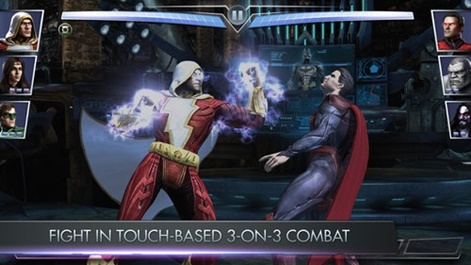
Contest of Champions retained some of the earlier Marvel: War of Heroes key success factors such as heavy usage of gacha and regular events, but built out a far more compelling game experience. They took a leaf out of the Injsutice playbook and used mechanics from fighting games and diluted them down to a simple experience that was suitable for mobile.
Combined with incredible production values and an overall slickness throughout the app, the studio had excelled in a new genre and one in which it was one of the dominant forces in. They had created a barrier to entry that was so high that few other developers could get in because of the top-notch graphics, sounds and the Marvel IP.
It’s that sort of position that must have convinced Netmarble to pounce. Transformers: Forged to Fight is the studio’s follow-up title in the mobile fighting game genre and the first global release since their acquisition.
The Transformers licence and the mobile market

Transformers as an IP is an interesting one. Initially developed as a toy line in Japan by Takara Tomy, there were successfully brought over to the West by Hasbro in the early 1980s
The toys proved to be a huge hit among boys and are fondly remembered by many who grew up during that time period. Such was their success that it even spawned an animated TV show!
However, over time, like many fads, it started to lose it’s allure and became less popular, until Hollywood director Michael Bay saw fit to create a live-action movie based on the IP in 2007, tapping into a retro-nostalgia period that had been kick-started by companies like Marvel with live-action adaptations of their own comic books.
The film proved to be a huge hit and at the time of writing the fifth movie entitled Transformer: The Last Knight is due for release in 2017 starring among others, Mark Wahlberg and oscar-winner Anthony Hopkins!

Given the huge popularity of the Transformers license, several attempts at making mobile games have been made from some very established mobile companies. Transformers: Legends was a surprise breakout hit for DeNA’s American studio, although it’s successor Transformers: Battle Tactics fared less successfully.
Transformers: Earth Wars, developed by Backflip / Space Ape was an attempt of applying the Clash of Clans build and battle loop to the franchise that is somewhat successful and often seen in the top 250 grossing games.
Finally, Rovio tried a fairly unique crossover game called Angry Birds: Transformers, which was a lot of fun if ultimately a failure compared to their Star Wars crossover products.
I think this shows that the IP has the potential to support a hit or near-hit game, but that it’s less alluring to customers compared to Disney licenses, such as the Marvel movies or Star Wars.
Core gameplay
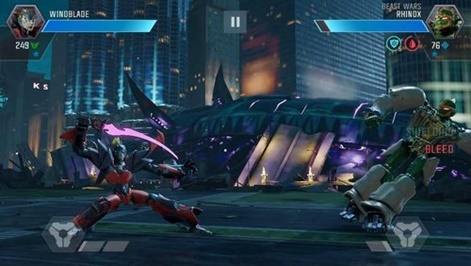
The core gameplay in Transformers borrows heavily from Contest of Champions. You pick a bot and battle against an enemy bot in a one on one fight. When either you or your enemy’s health is reduced to zero, the fight is over, and you either win the battle or move onto the next bot if you are up against a sequence of them.
During a battle, you have access to light, medium and heavy attacks, as well as blocking and dashing. In this game, when using a heavy attack, your bot changed to their alternate form and transforms which is a really cool way to utilise the USP of the licence and IP.
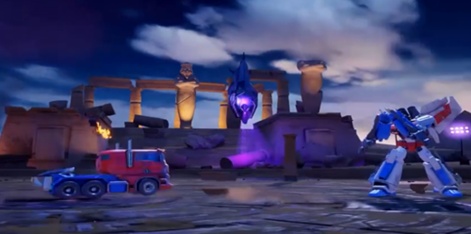
Transformers: Forged to Fight innovated on CoC’s fighting mechanics by adding ranged combat and the ability to sidestep into the battle. This makes the fighting more relevant to the IP and also makes the battle more fun as there is a wider choice of actions and counter plays you can make against your opponent.
As the game progresses, more subtle mechanics are also introduced such as attacks or effects that can Armor Break, Shield and Poison and suit purposes such as punishing Ranged Combat, etc. It creates a strong metagame of having to carefully choose which Robot you want to bring into battle against upcoming opponents.
Core Loops
[img id="76740" caption="View the full-sized image here."]
I’ve listed the game as having FOUR (!) separate loops. You might see the game structure as being a bit different to this, but I hope my diagram highlights a few things:
- The game is more than just a re-skin. It’s more like an evolution of the Contest of Champions game framework.
- There are a LOT of things to do in this game. Possibly too many.
- The game is complicated with a lot of different things to get your head around and remember.
- The game has a more diverse metagame than Marvel: Contest of Champions.
I’ll try to do each of the loops justice with their own sections, but you can think of the player motivations for each loop being as follows:
- PvE: Progress through the game story and unlock more content/bosses/locations.
- PvP: Raid other players to steal resources to improve your base and leaderboard rank for prizes.
- Bot Investment: Acquire new bots and resources. Spend those resources to improve the power or potential of your bots.
- Base Maintenance: Send bots out on missions to acquire more resources, and set bots up in defense to protect your base from enemy raids.
The key to all loops is that they synergise together through some central core principles. No matter which part of the game you decide to engage with, you will do better if you have a wide variety of different bots that have been upgraded to their maximum potential and power.
In order to do this, you will either have to grind the game for a very long time, or spend via gacha to accelerate the process.
PvE Loop
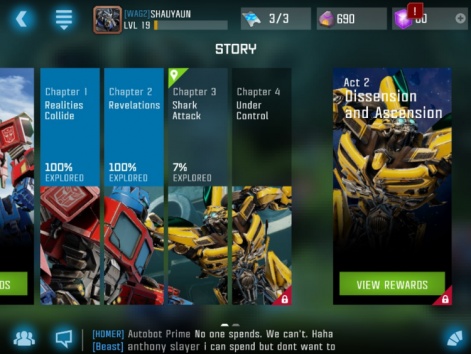
In typical Kabam Vancouver fashion, the game starts with a really well executed PvE mode. There’s a story based in the Transformers universe that acts as a conceit as to why you might have to battle another Autobot as Optimus Prime and is passable if you are into that kind of thing.
Each part of the story takes place on a 3D map, and as a player you have to semi-automatically navigate it, occasionally being able to choose different routes to clear the area.
At each node, you reach a new battle and this whole mode acts as a good motivator to wanting to progress through the game, improve your bot collection and acquire new bots when you reach an impasse.
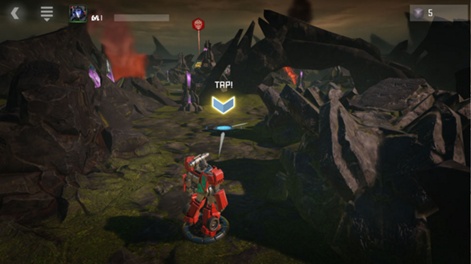
Essentially the PvE loop functions as extended tutorial without having to hold you hand too much. It gets you familiar with all of the basic mechanics and inner workings of the game so you are ready to fight against other players in the game’s PvP modes.
Home Hub Screen
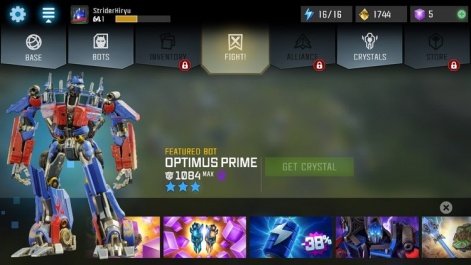
Given the wealth of things to do and manage in the game, the UI and UX is separated out into a variety of tabs and attractive Metro UI style blocks to show you what is available.
The game also has a really slick introduction screen / sequence that plays whenever you return to the game, up selling various top prizes you can get from the gacha. It almost feels like Windows 10 or the iOS home screen when you buy an iPhone for the first time and just adds to the overall polish of the game.
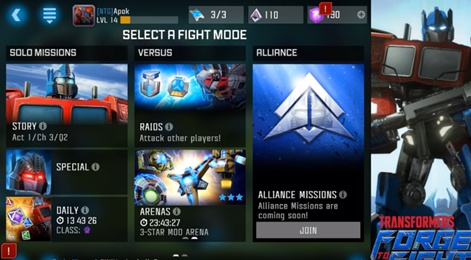
Though the UI is sometimes cluttered or feels a little “full-on” in terms of things going on at any one time, it does a good job at allowing you to quickly navigate to the actions that are of most interest, and also of foreshadowing content and features that will appear later in the game.
Bot Investment Loop
[img id="76745" caption="These diagrams are taken from Vinayak’s Contest of Champions deconstruct, as they are applicable almost 1-1 to Forged to Fight. Items are given different names, for example Shards are known as Sparks in Transformers, but their purpose is the same."]
This game uses the tried and tested progression/monetisation from Contest of Champions. These consist of a series of systems and subsystems that synergise together to incentivise players to want to collect as many characters as possible and to upgrade them to their fullest potential.
These are very strong progression systems as they provide the player with a multitude of things to do:
- Upgrade high level characters by ranking them up. This is a real grind but these are the most powerful heroes that will allow you to progress the most.
- Recruit new low level characters of new types you don’t have to fill in weaknesses in your squad to allow you to beat missions or strategy types that you are currently weak against.
It means that as a player you are moving through different parts of the game and going through all of the loops to improve your bots at different times in your player life-cycle / journey.
This keep the game fresh as on one day you might spend time grinding the arenas for resources for your high level characters, but on another you might be sending out low level bots to collect resources for your base, etc.
PvP Loop
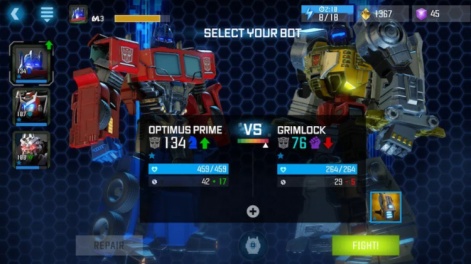
PvP in Transformers is called Raiding and varies quite a bit from Marvel Contest of Champions. When you attack other players, you actually attack their base meaning that you can steal their resources (and they can steal yours).
This creates a Clash of Clans-style revenge behaviour where players get caught up attacking and retaliating that neither earns enough resources to progress.
In Transformers, when you raid an opponent's base, you are given a selection of opponents to attack who appear on the enemy’s base according to the layout they have selected (more on this in the next section).
This allows for some interesting strategic choices on both offence and defense and adds a lot to the metagame of which units to choose in order to get the most success out of the current most popular choices online.
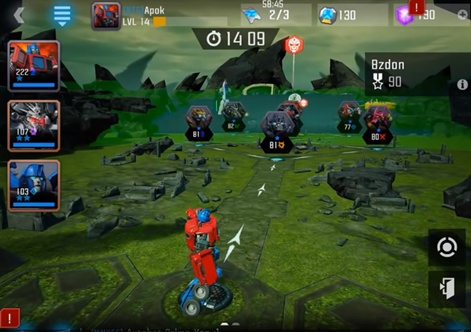
To play PvP, a specific PvP currency is required which refills over time. Interestingly players are given 15 minutes to clear out the enemy base, which means that in PvP Raiding, a lengthier time expectation is put onto the player than in other modes.
Base Maintenance Loop
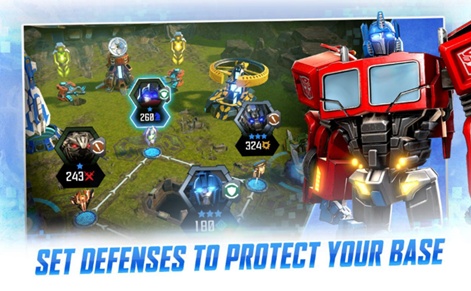
The new base layer of the game means that players are incentivised to spend time optimising their base layout. You can put bots on defense to protect your base, but this means they can’t be used to attack.
Enemies can raid your base by choosing a route, ultimately having to defeat a boss character you place at the back of your base. This allows for some cool strategies as by placing bots up front that are different than ones behind, meaning that opponents need to mix their attack force in order to defeat yours.
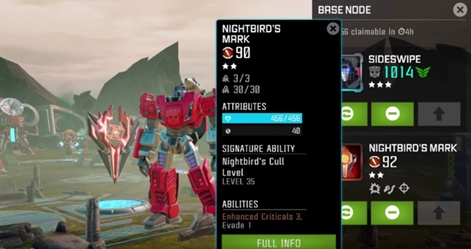
Additionally you also place mods on each of the nodes that upgrade the abilities or provide unique effects on the bot stationed there, such as making their first special unblockable.
This creates an interesting “noodling” loop of optimising your base from attacks which is enjoyable and light enough to not have to worry about more complex mechanisms such as base design from Clash of Clans.
Players can also buy shields if they don’t want to be attacked at all, which provides another monetisation mechanic.
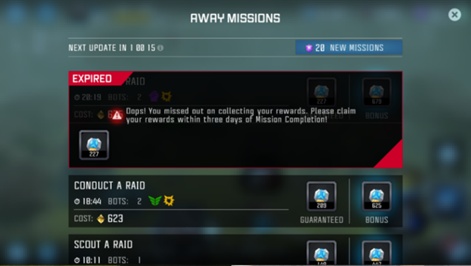
Finally, players can also send bots on away missions to collect resources. As the name suggests, this means the bots can’t be used for either attack of defense whilst they are away but helps you upgrade your bots and base.
It provides a good use of your many duplicate one star bots that you will acquire during the game which start to run out of uses later in the game as their trade-in value through the game’s version of fusion becomes less appealing.
Social / Alliances
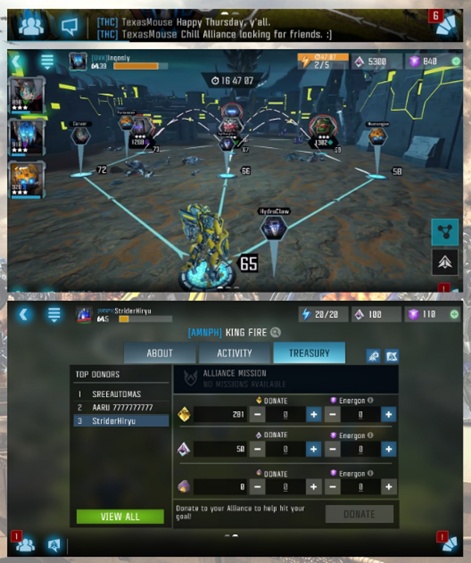
When Contest of Champions first launched, it was light in terms of social and alliance play. However, as development on the game continued the team released several large updates to build out that part of the game and it looks like all of those learnings have been taken into Forged to Fight too.
The game has a persistent chat channel that is always live in the game, even when you first start out. This is often filled with angst-ridden teenagers with some pretty aggressive chatter, but it does make the game feel alive and social from the get off.
Joining an Alliance allows you to request energy and stamina resources from your friends and rewards the benefactor with loyalty points, which can be spent to purchase Alliance Crystals for powerful rewards. This creates a healthy cycle of wanting to work together and reciprocating to help all members of the alliance.
There is a wide variety of sophisticated guild features, including a Treasury, Generals and officers and an Alliance specific news feed. There’s also an Alliance gacha that is opened up with rewards that are relevant to all Alliance members.
Alliance Quests
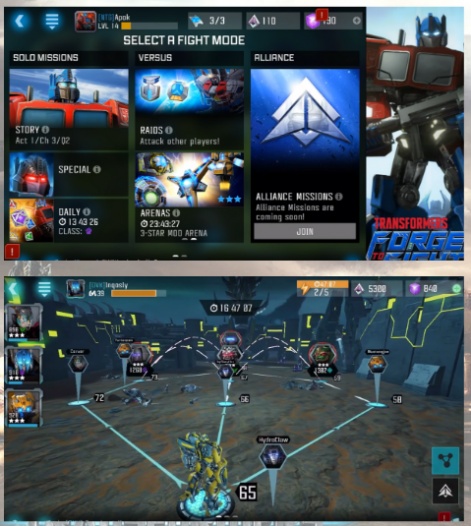
Alliances are primarily used for Alliance Quest and Events. This is the very top of the elder game and could be a loop unto itself. Essentially alliance members for groups of 6 to complete quests within a limited time frame.
Using the base mechanics from the Raid metagame, these quests use an Alliance energy mechanic and have links between several of the bots in the quest. Fighting a linked bot before it’s generator bot has been destroyed is almost impossible, to Alliances have to coordinate so that each member defeats the next bot to unlink it from a team-mate's path.
It perhaps sounds more complicated than it is, and is actually a lot of fun and encourages players to work together and communicate a lot. Most players tend to use Line messenger in addition to the in-game alliance chat system and it helps build a community spirit outside of the game.
Final Thoughts and Observations
The overall technical and artistic quality of this game is incredible. There’s probably only one other game on mobile that comes anywhere close to looking as good as this game, it’s predecessor, Contest of Champions.
In terms of system design, this game is incredibly ambitious. The systems are well designed, with each part of the game serving its own purpose.
However, despite that technical brilliance, as of writing Transformers: Forged to Fight is a huge flop lying outside of the top 250 grossing games in the USA and below Transformers: Earth Wars, a Build and Battle style game released by Backflip / Space Ape in 2016. That's a huge disapointment given the success of Marvel.
In terms of system design, this game is incredibly ambitious. The systems are well designed, with each part of the game serving its own purpose as well as synergising into the overall game and paragame.
However, this comes at the price of intuitiveness. This game has a *lot* of complexity, as there are so many different currencies, game actions, and game modes.
Even with acknowledgments to this complexity in the form of home hubs and streamlined UX, as a player, you often open the game and are bewildered with a number of things you can do and it’s not that obvious what to do next.
This isn’t necessarily a problem as breadth and depth of content along with deep sinks means that it takes a long time or a large amount of money to get through all of the content in the game, by which time through live ops there will plenty more to get through. This approach generally leads to both increased player LTVs and long-term retention.
However, the price you pay in terms of this sort of complex system design is that you will lose players in the early game who don’t know or understand what to do next.
As of writing, despite having Apple’s editor’s choice featuring, the game is outside the top 150 grossing games in the USA, despite being in the top 25 most downloaded games.
So it makes me wonder if the Transformers audience struggles with a very deep game design. We’ll have to wait and see I guess, as I assume when the new movie is out, a lot more marketing will take place around the product.
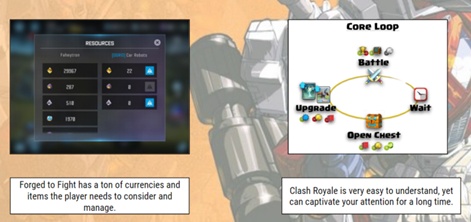
I think a good comparison is to compare the paragame* of Transformers with the paragame of Clash Royale.
Whereas you could read a lengthy deconstruction of Transformers such as this and still not really understand the progression systems at length, you can understand Clash Royale’s win battles/earn cards/upgrade card paragame in a very short space of time.
That makes it far easier to be mass-market and far easier to get a lot more players into the game.
Kabam has tried to innovate subtly with their basic framework, but perhaps the underlying structure relies too much on the Marvel IP.
Another noticeable design choice in the game is to use quite lengthy game time requirements for players in core aspects of the game. For example, players have 15 minutes to clear out an enemy raid which is a lot longer than your typical five-minute game loop “rule”.
As the mobile player base matures, this is something that is becoming more common as engaged players will often play for far longer than five minutes at a time
As long as players get to make many meaningful actions during this time period, they’ll be prepared to play for longer and in the case of this game, fights can be very moorish when trying to clear out another player’s base.
Ultimately though, I am surprised that Transformers is not looking like a consistent top 50 hit. Despite having a world-class team behind it with over two years worth of Product and live ops experience, the IP does not seem to be resonating with the public.
Kabam has tried to innovate subtly with their basic framework, but perhaps the underlying structure relies too much on the Marvel IP and not enough on a sticky experience that keeps players engrossed for as long as they would like.
As a result, it will be interesting to see Kabam's next move with the game. The movie is out in June, which should result in a re-feature and / or a UA push, but given the initial reaction of the game, I’d be surprised if the engine isn’t already being spun up to make a third game, with this one taking backseat, given Netmarble’s recent acquisition.
As of right now, you'd have to say that acquisition looks expensive.
* NB: In this article, I am using terminologies proposed from Carter, Gibbs and Harrop’s abstract released in 2012. A Metagame describes higher level player strategy outside of a game’s core mechanics. E.g. in Hearthstone an Aggro deck counters a Combo deck even though the cards it uses may be on average of worse quality. A paragame describes the loops and progression actions players go through to support the core gameplay.




















